Religion Presbyterian Known for Hayes Code | Spouse Jessie Hays Name Will Hays | |
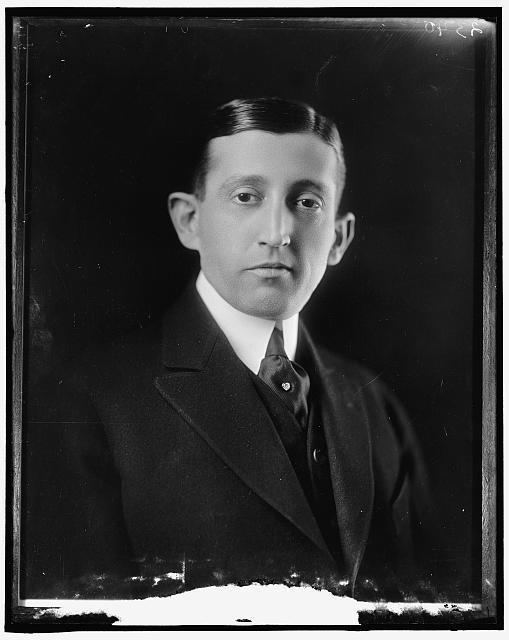 | ||
Full Name William Harrison Hays Born November 5, 1879Sullivan, Indiana, U.S. ( 1879-11-05 ) Profession Politician, President of the MPAA Books Come Home with Me Now: The Untold Story of Movie Czar Will Hays by His Son, Loose on the Wind, See and Hear Similar People William Henry Harrison, Benjamin Harrison V, Carter Bassett Harrison | ||
William Harrison Hays, Sr. (; November 5, 1879 – March 7, 1954) was a United States politician, chairman of the Republican National Committee (1918–21), U.S. Postmaster General (1921–22), and, from 1922–1945, the first chairman of the Motion Picture Producers and Distributors of America (MPPDA). He became the namesake of the 1930 Motion Picture Production Code, informally (and inaccurately) referred to as the Hays Code, which spelled out a set of moral guidelines for the self-censorship of content in Hollywood cinema.
Contents
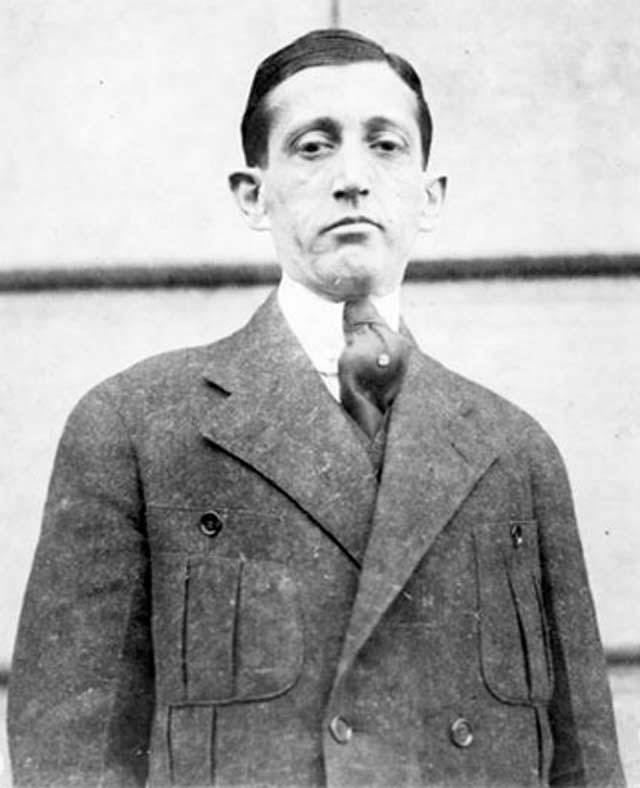
Biography

Hays was born in Sullivan, Indiana, on November 5, 1879, and attended Wabash College in Crawfordsville, Indiana. He was the manager of Warren G. Harding's successful campaign for the Presidency of the United States in the 1920 election and was subsequently appointed Postmaster General. While serving in the Harding Administration, he became peripherally involved in the Teapot Dome scandal.
Teapot Dome scandal
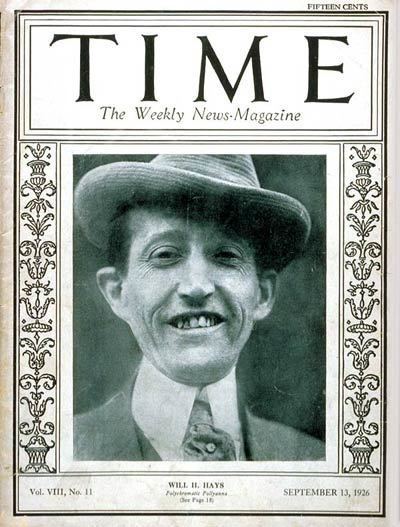
Oilman Harry Ford Sinclair devised a scheme in which twenty five cents was diverted from the sale of every barrel of oil sold from the oil field leases that were the focus of the Teapot Dome scandal. Sinclair testified that he "loaned" Will H. Hays, then-chairman of the Republican National Committee, $185,000 worth of Liberty Bonds, later getting back $100,000. Sinclair also gave Hays $75,000 as an outright gift to the Committee. At the time, Hays was attempting to pay off the 1920 Republican campaign debt. Hays later approached a number of wealthy men and told them that if they would contribute to pay down the Committee's debt, he would reimburse them for their contributions with Liberty Bonds.
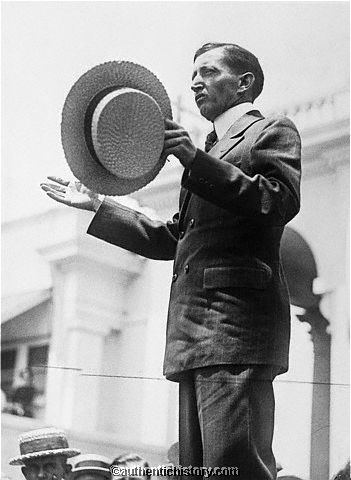
In 1924, after his resignation from the Harding administration and while he was serving as President of the Motion Picture Producers and Distributors of America, Hays was called to testify before the Senate Committee on Public Lands. When asked how much money Sinclair had contributed to the Republican Party, Hays testified that his contribution was $75,000. In 1928, after more details of Sinclair's scheme had emerged, Hays was called to testify again. Hays then told the full story of Sinclair's contribution, including the donation of $185,000 in Liberty Bonds and the $75,000 cash contribution. He stated that he had not mentioned the bonds in his earlier testimony because the Committee "had not asked about any bonds." While there was some public perception that Hays was attempting to conceal Sinclair's large contribution to the Republican National Committee, he testified that he was "using the bonds to raise money for the deficit."
Head of MPPDA
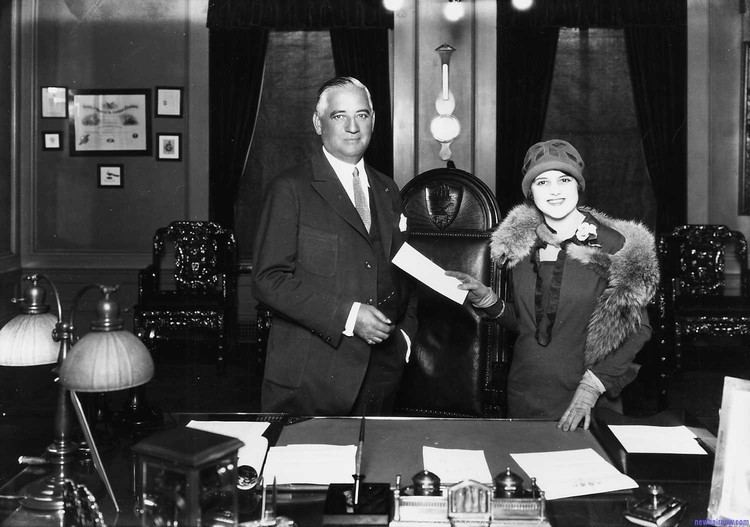
Hays resigned his cabinet position on January 14, 1922, to become President of the Motion Picture Producers and Distributors of America (MPPDA) shortly after the organization's founding. He began his new job, at a $35,360 annual salary (equivalent to $510,000 in 2016), on March 6 of that year. There was speculation that he would be paid between $100,000 and $150,000 a year.
The goal of the organization was to renovate the image of the movie industry in the wake of the scandal surrounding the alleged rape and murder of model and actress Virginia Rappe, of which film star Roscoe "Fatty" Arbuckle was accused, and amid growing calls by religious groups for federal censorship of the movies. Hiring Hays to "clean up the pictures" was, at least in part, a public relations ploy and much was made of his conservative credentials, including his roles as a Presbyterian deacon and past chairman of the Republican Party.
In his new position in Hollywood, Hays' main roles were to persuade individual state censor boards not to ban specific films outright and to reduce the financial impact of the boards' cuts and edits. At that time, the studios were required by state laws to pay the censor boards for each foot of film excised and for each title card edited; in addition, studios also had the expense of duplicating and distributing separate versions of each censored film for the state or states that adhered to a particular board's decisions.
Hays attempted to reduce studio costs (and improve the industry's image in general) by advising individual studios on how to produce movies to reduce the likelihood that the film would be cut. Each board kept its "standards" secret (if, indeed, they had any standardization at all), so Hays was forced to intuit what would or would not be permitted by each board. At first he applied what he called "The Formula" but it was not particularly successful; from that he developed a set of guidelines he called "The Don'ts and Be Carefuls". In general his efforts at pre-release self-censorship were unsuccessful in quieting calls for federal censorship.
Catholic bishops and lay people tended to be leery of federal censorship and favored the Hays approach of self-censorship; these included the outspoken Catholic layman Martin J. Quigley, publisher of Exhibitors Herald-World (a trade magazine for independent exhibitors). For several months in 1929, Martin Quigley, Joseph Breen, Father Daniel A. Lord S.J., Father FitzGeorge Dinneen S.J., and Father Wilfred Parsons (editor of Catholic publication America) discussed the desirability of a new and more stringent code of behavior for the movies. With the blessing of Cardinal George W. Mundelein of Chicago, Father Lord authored the code, which later became known as "The Production Code", "The Code", and "The Hays Code". It was presented to Will Hays in 1930 who said, "My eyes nearly popped out when I read it. This was the very thing I had been looking for".
The studio heads were less enthusiastic and they agreed to make The Code the rule of the industry but with many loopholes that allowed studio producers to override the Hays Office's application of it. From 1930 to 1934, the Production Code was only slightly effective in fighting back calls for federal censorship. However, things came to a head in 1934 with widespread threats of Catholic boycotts of "immoral" movies as well as reduced funding by Catholic financiers such as A. P. Giannini of the Bank of America. The studios granted MPPDA full authority to enforce the Production Code on all studios, creating a relatively strict regime of self-censorship which endured for decades. (The Code was set aside in the 1960s when the MPAA adopted the age-based rating system in force today.) Also in 1934, to address industry personnel alongside the Code's concern with the industry's output, Hays created a list of 117 names of performers whose personal lives he thought made them unfit to appear in films.
Hays' philosophy might best be summed up by a statement he reportedly made to a movie director: "When you make a woman cross her legs in the films, maybe you don't need to see how she can cross them and stay within the law; but how low she can cross them and still be interesting".
Hays faced much international pressure to block film scripts and scenes offensive to foreign nations. Many European nations imposed quotas designed to boost domestic productions over Hollywood imports. A central accomplishment of Hays was his ability to work with the U.S. government, particularly the U.S. State Department and the U.S. Department of Commerce, in order to maintain Hollywood's domination of overseas movie markets.
Death
After his retirement, Will H. Hays returned to Sullivan, Indiana, where he died on March 7, 1954. His widow died in 1960.
Production Code
The Production Code enumerated three "General Principles":
- No picture shall be produced that will lower the moral standards of those who see it. Hence the sympathy of the audience should never be thrown to the side of crime, wrongdoing, evil or sin.
- Correct standards of life, subject only to the requirements of drama and entertainment, shall be presented.
- Law, natural or human, shall not be ridiculed, nor shall sympathy be created for its violation.
Specific restrictions were spelled out as "Particular Applications" of these principles:
